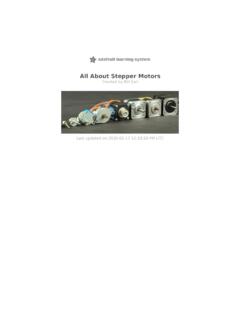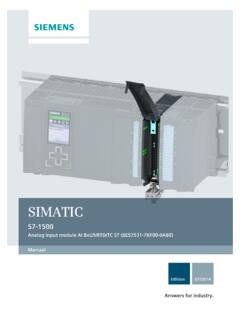Transcription of Everything you need to know about NMEA 0183 - Actisense
1 Everything you need to know about NMEA Important NoticesNotices Feedback2. NMEA 0183 IntroductionThe Basics3. Electrical SpecificationNMEA 0183 + TalkersNMEA 0183 TalkerOther TalkersNMEA Talker Limitations4. NMEA Listener SpeficationsCommunication Specification5. NMEA 0183 StandardThe Differing Versions of the 0183 StandardFormat ChangesIntroducing Actisense ISO-Drive6. Actisense 0183 Product RangeMultiplexers - NDC-4, NDC-5, PRO-MUX-1 Buffers - NBF-3, PRO-BUF-1 Digital Transducers - DST-2 Gateways & PC Connectivity - USG-2, NGW-1, OPTO-4, USB-KIT7. Connecting NMEA Talkers to NMEA Listeners Differential NMEA Talkers8. ISO-Drive Technology9. Single Ended Talker10. Connecting a Computerr to an 0183 NetworkReccomended Connection MethodConnecting a PC without a Serial Port (Using USB)Testing an NMEA 0183 Connection to a PCExample NMEA 0183data vs + 11. Understanding NMEA 0183 SentencesUnderstanding the NMEA 0183 Sentence Format12.
2 Useful NMEA Resources1 2021 Active Research Limited. All rights - Important NoticeThis Actisense document is for informational purposes only, and to our best knowledge the information contained within is accurate and true. Any use of information contained within this document is done so at the user s own risk. No responsibility will be accepted for any personal injury or damage to a boat or it s connected equipment resulting directly or indirectly from information contained equipment used on board a boat can be critical to the safe passage of the vessel, so if in doubt, contact an NMEA certified marine electronics installer before attempting any modifications to your current system. Unfortunately, we cannot publish the full NMEA 0183 standard in this document, as it is copyrighted by the NMEA. A full copy of the standard is available from the NMEA web-site: We highly recommend that anybody attempting to design or install NMEA 0183 equipment into an NMEA 0183 network obtains an official copy.
3 NoticesThe information contained within this document and any specifications thereof may be changed without any prior notice. To obtain the most up to date information, contact us or visit our website: Research Limited will not be liable for infringment of copyright, industrial property right, or other rights of a third party caused by the use of information or drawings contained within this document. All Rights are Reserved: The contents of this document may not be transferred or copied without the expressed written consent of Active Research Limited. FeedbackThis document has been produced using the knowledge gained over many years of working with the NMEA and the Marine Industry. Please report any errors, omissions or innacuracies straight to Actisense . We intend for this document to be used as a useful resource for installers who are new to the NMEA 0183 standards and devices, and inevitably we may have missed out the vital piece of information required for your particular installation to have a working NMEA 0183 network.
4 If you have any questions, please contact us directly. 2 2021 Active Research Limited. All rights - NMEA 0183 IntroductionThe NMEA developed a standard over 20 years ago that defines the interfacing between various pieces of marine electronic equipment and navigational computers. Allowing them to talk together and share vital information. The NMEA 0183 standard slowly became the common method by which marine electronic devices could talk to one another. The standard specifies both the electrical connections that make up an NMEA system, the communications method of transferring the data, and the format of the sentences which carry the NMEA data. The NMEA 0183 standard is a purely digital data transmission method, using a binary format of 1 and 0 , to communicate a digital representation of the required data to a connected device. NMEA 0183 evolved from the earlier standards (NMEA 0180 and 0182). However, because they differ in baud rate and transmission parameters, they are not compatible with NMEA 0183.
5 Similarly, the newer NMEA 2000 standard is completely different, and the two networks cannot be mixed without a specialist gateway device in between converting the two standards, such as the Actisense NGW-1. The BasicsThe NMEA standard defines the electrical signalling, data protocol and sentence formats for a 4800/38400 baud serial data bus. NMEA data is transmitted from a source such as a GPS, depth sounder, compass These devices are called Talkers . Equipment receiving this data, such as a Chart Plotter, Radar, PC, NMEA Display are called Listeners . Each NMEA 0183 connection / bus will have one talker, but is capable of many listeners. The Talker and Listener sections of this document explain why this is the case. 3 2021 Active Research Limited. All rights - Electrical SpecificationThe latest specifications for NMEA 0183 ( version 2 and onwards) should, as a minimum, meet the requirements of the computer standard RS422 (Standard EIA-422-A).
6 They use +5 / 0 volt signalling, which is low voltage and easy to interface to computer equipment. However, voltage levels present on an NMEA 0183 network can be much greater - up to +/- 15 volts, particularly where older equipment is used, as the original version 1 specification used +/- 12-15 volt signalling. Thus, all NMEA 0183 inputs conforming to and higher should be capable of receiving +/- 15 volt differential signals without suffering NMEA 0183 specification also requires that all receiving equipment must be opto-isolated; this opto-isolation requirement reduces the chances of interference and re-moves the problem of ground loop connections should be made using twisted pair cabling, with a shield . To prevent ground loops, the shield should only be connected at one end - NMEA specifies that the shield should be connected to the Talker 0183 + TalkersAs specified in RS422, version 2 and newer NMEA connections are labelled A , B and shield .
7 Sometimes the signals are label Data + and Data -, these relate to NMEA A and NMEA B signal states provided by the Talker are those specified in EIA-422-A. This states that the logical 1 or STOP bit state is defined by a negative voltage on line A with respect to line B . A logical 0 or START bit is defined by a positive voltage on line A with respect to line B . A pictorial representation of an RS422 type talker can be seen in the diagram:The A is the regular output from the amplifier, and the B is the inverted output. The shields of all LISTENER cables shall be connected to the TALKER chassis only and shall not be connected at each practice, this means line A is zero volts and line B is at 5 volts on an NMEA output when a logical 1 is present,. For a logical 0 line A is at 5 volts and line B is at 0 volts. These voltages would be present only when no load is 2021 Active Research Limited.
8 All rights - Electrical Specification ( )NMEA 0183 TalkerNMEA 0183 version 1 talkers used slightly different connection methods and signal levels. Devices had just one NMEA data line ( Tx Data or Out ), and used the ground as the other line - similar to a computer serial port. This connection method is referred to as single ended instead of the differential method used by NMEA 0183 1 talkers also had signal levels similar to that used in the computer RS232 standard. Here, the data signalling voltage was up to +/- 15v, and the logical 1 or STOP bit state is defined to be within the range -15 to + The logical 0 or START bit was defined to be within the range + to + TalkersMany devices are produced that are fully compliant with the NMEA 0183 standard. Most simply label the outputs as DATA or TX , and use the system ground line as the B line, as per the version 1 standard, but often the drive voltage is 5 volts, as used in version 2+.
9 Many of these talkers are labelled as version 2, but in this case they are referring to the contents of the data format, not the talker. Another limitation of these circuits is that they often use low power driver chips, and thus can often only talk to one listener instead of many. This means that an NMEA Buffer such as the Actisense NBF-3 must be used to drive multiple Talker LimitationsNMEA Talker outputs cannot be turned off, or switched into a receive mode, which means that the outputs are continuously driven. This is why only one talker can be present on a single NMEA 0183 network at any one time. To combine data from multiple talkers, you must use a multiplexer, such as the Actisense NDC-5. This safely receives the data from multiple talkers, and combines it together into a single stream. Two or more Talkers are simply not possible on the same data line as they are not synchronised to each other, and will attempt to talk at the same time (over each other).
10 It is also likely that one Talker will have a stronger drive circuit, and the other talker will not even get to send will result in corruption or total loss of the NMEA data, and potentially in disaster if valuable data such as navigation information is lost or corrupted. Connecting two talkers together can even lead to one or both of the Talkers becoming damaged. A Talker can be connected to multiple Listeners, but often many talkers used in electronic devices on the market do not provide enough driver current to talk to more than one or two listeners at one time, thus special NMEA amplifiers or buffers need to be 2021 Active Research Limited. All rights - NMEA Listener SpecificationA listener must operate with a minimum differential input voltage of Volts, and not take more than from the line at that voltage. The NMEA standard document shows a circuit that will meet this requirement. Actisense has designed it s own OPTO input circuit which exceeds this requirement, extending the range that valid data can be successfully Listener must also be OPTO isolated to prevent ground loop problems.



